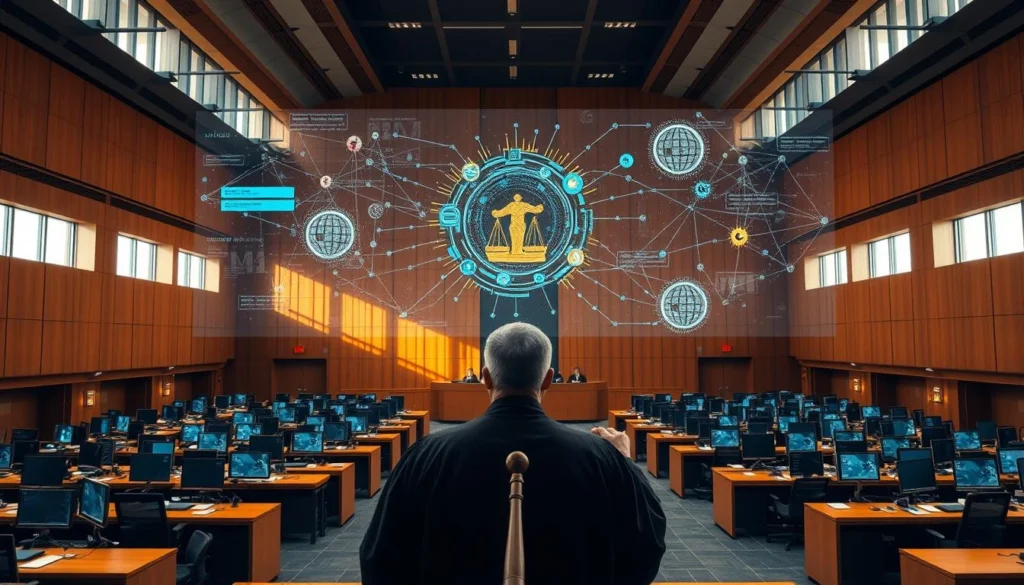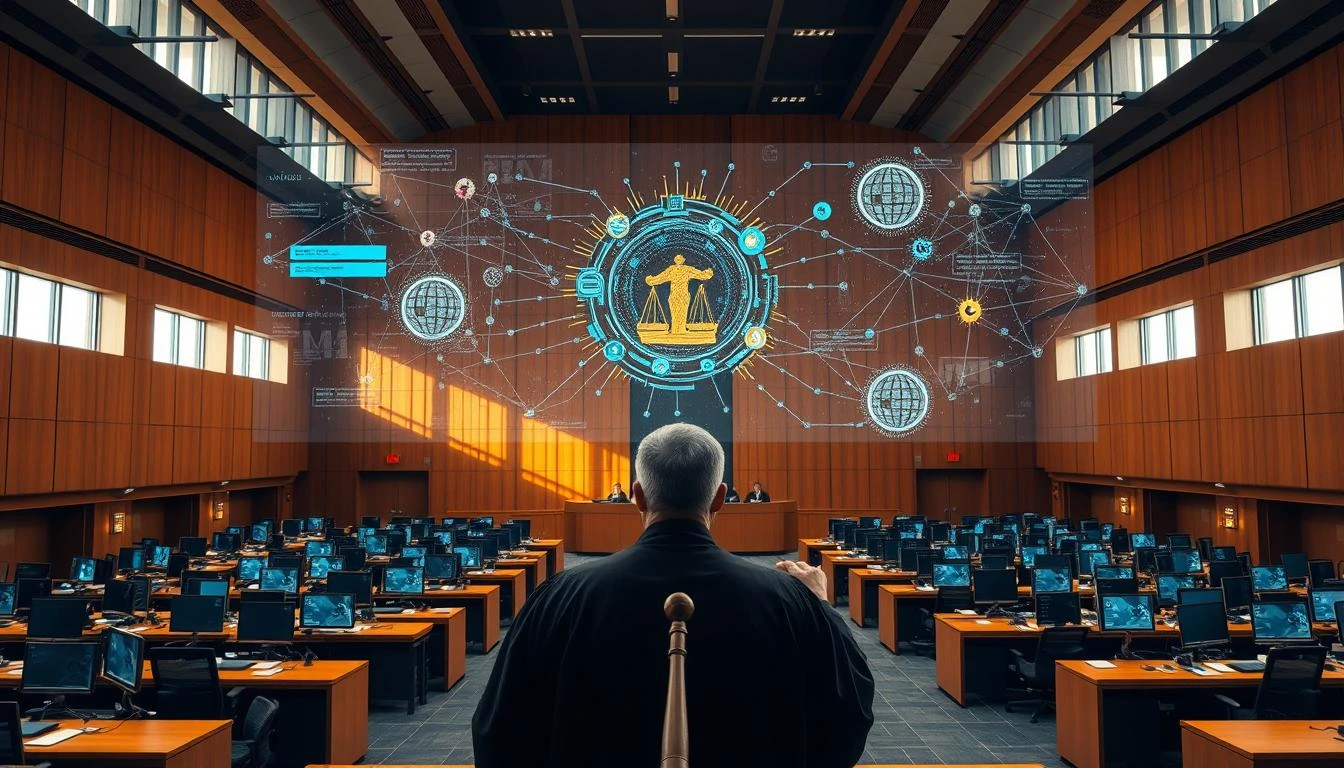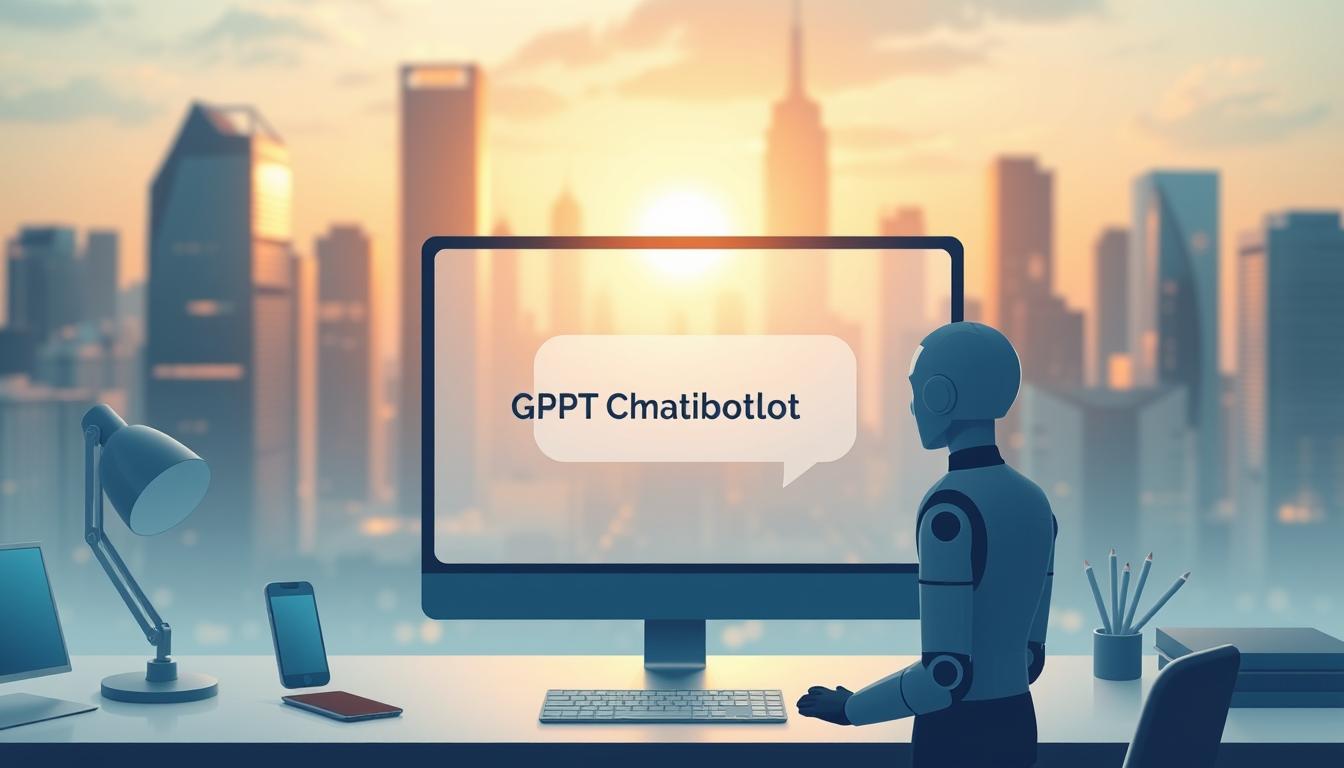Can technology revolutionize the way justice is administered? As artificial intelligence becomes increasingly embedded in our daily lives, it’s transforming the justice landscape as well.
The judiciary is leveraging technological advancements to improve the administration of justice. From virtual assistants to complex algorithms, AI is being deployed at various stages of the justice process.
This integration raises important questions about the potential benefits and challenges of relying on technology in the justice system. As we move forward, understanding the role of intelligence in this context is crucial.
Key Takeaways
- The increasing presence of AI in the justice system is transforming traditional legal processes.
- AI tools are being used at various stages, from case filing to sentencing.
- Understanding AI’s role is crucial as it becomes more prevalent in courtrooms and law enforcement.
- AI has the potential to address longstanding challenges such as case backlogs and inconsistent decision-making.
- The future of AI in justice will depend on balancing benefits with ethical considerations.
The Evolution of AI in Justice Systems
AI’s role in modernizing justice systems is a story of gradual yet profound change. The justice system has seen a significant transformation with the integration of AI technologies, impacting how legal professionals work and the tasks they perform. This evolution has been pivotal in enhancing the efficiency and equity of judicial outcomes.
From Manual Processes to Automated Systems
The transition from manual to automated systems in the justice system has been transformative. Initially, legal processes were largely paper-based and manual, consuming considerable time and being prone to errors. The introduction of early digital systems marked the beginning of a new era, with AI tools eventually taking over routine tasks and allowing legal professionals to focus on more complex work.
AI-driven tools have enabled court and government employees to shift their focus towards more human-centric tasks, improving interactions and outcomes. By automating routine processes, AI has provided learning opportunities to enhance equity and reduce bias in judicial decisions.
Key Milestones in Justice System AI Adoption
The adoption of AI in justice systems has been marked by several key milestones. The introduction of document processing systems, risk assessment tools, and predictive analytics has significantly impacted how justice is administered. Early implementations of machine learning in legal contexts laid the groundwork for today’s sophisticated AI applications.
- The deployment of AI tools in courts and clerks’ offices over the past five years has reduced inefficiencies and errors in the filing process.
- Pioneering jurisdictions have led the way in implementing AI solutions, setting standards for others to follow.
- The roles and responsibilities of various stakeholders in the justice system have evolved, with judges, lawyers, and court administrators adapting to new technologies.
As the justice system’s relationship with technology continues to evolve, it’s clear that AI will play an increasingly significant role in shaping its future. The learning opportunities provided by AI will be crucial in improving judicial outcomes and ensuring that the justice system remains equitable and efficient.
Current Applications of AI in the Justice System
AI tools are revolutionizing the justice system by streamlining processes and enhancing decision-making. The integration of Artificial Intelligence (AI) in the criminal justice system is transforming the way legal proceedings, law enforcement, and law-making take place.

Document Processing and Case Management
AI is being utilized for document processing and case management, significantly improving the efficiency of legal proceedings. For instance, Palm Beach County’s Lights-Out Document Processing program achieved a 98% to 99% accuracy rate in analyzing document filings and tagging them with appropriate information. This level of accuracy surpasses human capabilities, reducing the likelihood of errors and increasing the speed of processing.
Legal Research and Analysis
AI is also revolutionizing legal research and analysis by enabling attorneys to quickly sift through vast amounts of dataand case law to build stronger arguments. This not only saves time but also enhances the quality of legal representation.
Risk Assessment and Predictive Policing
The use of algorithms for risk assessment and predictive policing is another significant application of AI in the justice system. These tools evaluate various factors to predict recidivism and influence decisions about bail, sentencing, and parole. While controversial, they represent a growing trend in criminal justice.
Facial Recognition and Surveillance
AI-powered facial recognition and surveillance technologies are being deployed in law enforcement, raising both effectiveness and privacy concerns. These technologies analyze data to identify individuals and monitor activities, contributing to the broader landscape of policing and public safety.
By integrating these AI applications, the justice system can create a more cohesive and efficient approach to administration, ultimately enhancing the rule of law and public trust.
AI-Powered Tools Transforming Legal Advocacy
The integration of AI tools in legal advocacy is revolutionizing the way public defenders operate, particularly in resource-constrained environments. By leveraging these technologies, public defender offices can enhance their capabilities and provide more effective representation to their clients.
Enhancing Public Defender Resources
Public defender offices, such as Miami-Dade County’s, are pioneering the use of large language model AI tools to aid in legal document drafting and research. This adoption of AI tools helps bridge the resource gap between well-funded prosecutors and under-resourced public defenders, potentially leading to more equitable outcomes in criminal justice.
The Los Angeles County Public Defender’s Office has also integrated AI solutions into their toolkit, focusing on humanizing defendants by organizing case information around people rather than case numbers. This approach not only streamlines their workflow but also enhances the quality of representation.
AI-Assisted Legal Document Preparation
AI-assisted document preparation is another area where these technologies are making a significant impact. By automating the creation of motions, briefs, and other legal documents, AI helps attorneys focus more on client interaction and case strategy, thereby improving the overall quality of legal representation.
The use of AI in legal advocacy is not limited to document preparation. It also extends to research and analysis, helping attorneys to build stronger cases. Moreover, the collaboration between AI systems and legal professionals can lead to more effective law enforcement and better allocation of resources.
The Impact of AI in Criminal Justice Decision-Making
The integration of AI in criminal justice decision-making is transforming the way judges and parole boards make critical decisions. AI tools are being used to inform and support decision-making processes, particularly in sentencing and parole determinations.
Sentencing and Parole Determinations
AI software is being utilized to score offenders’ risk of re-offending, advising judges on sentencing options such as incarceration or alternative punishments. A Tulane University study assessed the use of AI tools in over 50,000 convictions in Virginia, finding that AI could help correct gender and racial bias in judicial decisions. The New York State Parole Board uses the COMPAS Risk and Needs Assessment tool to support parole decisions, evaluating the likelihood of recidivism based on factors like education level and reentry plans.
| AI Tool | Purpose | Factors Considered |
|---|---|---|
| COMPAS Risk and Needs Assessment | Support parole decisions | Education level, age at conviction, reentry plans |
| AI Software (Virginia Study) | Inform sentencing decisions | Risk of re-offending, demographic factors |
Recidivism Prediction and Risk Assessment
Risk assessment tools like COMPAS are being examined for their role in predicting recidivism. These tools calculate risk scores based on various factors, including a person’s education level and age at the time of conviction. While AI can help mitigate bias, there’s concern that risk factors may be weighted in a way that perpetuates existing biases. I’ll explore how these tools are used and their impact on decision-making.

The complex relationship between algorithmic recommendations and human judgment is critical in the decision-making process. As AI continues to influence criminal justice decisions, it’s essential to consider both the benefits and challenges of these technologies.
Benefits of AI in the Justice System
The justice system is experiencing a paradigm shift with the introduction of AI. By leveraging AI’s capabilities, the justice system can address some of its long-standing challenges more effectively.
Efficient Resource Allocation
AI automates routine tasks, allowing judiciary members to focus on complex aspects of cases. This increased efficiencyboosts productivity and helps finish cases quickly. AI optimizes resource allocation by identifying areas needing human attention and handling repetitive tasks.
Enhanced Accuracy
AI enhances accuracy in legal processes, from document analysis to evidence evaluation. By reducing human error and improving consistency, AI contributes to more precise decision-making and fair outcomes. AI solutions increase accuracy in detecting suspects and making predictions.
Addressing Case Backlogs
AI helps the judiciary system cope with the enormous number of cases by streamlining processes and reducing delays. By implementing AI, courts can address the chronic problem of case backlogs, leading to improved access to justice for citizens and better working conditions for legal professionals.
Overall, the integration of AI in the justice system yields numerous benefits, including improved efficiency, enhanced accuracy, and reduced case backlogs, ultimately leading to a more effective and fair justice system.
Ethical Challenges and Concerns
The integration of AI in the justice system, while promising, raises significant ethical concerns that need to be addressed. As we move forward with AI implementation, it’s crucial to examine the challenges associated with its use.
Bias and Fairness Issues
One of the primary concerns with AI in the justice system is bias. AI systems can become biased if the data used to train them is biased towards a particular group of people. This can lead to unfair outcomes, particularly affecting marginalized communities. Research has shown that biased algorithms can perpetuate existing inequalities, making it essential to address these bias issues to ensure fairness in legal proceedings.

Transparency and the “Black Box” Problem
Another significant challenge is the “black box” nature of AI algorithms. The decision-making process of these algorithms is often opaque, even to their developers. This lack of transparency makes it difficult to understand how conclusions are reached, raising concerns about accountability. The tension between algorithmic complexity and transparency is particularly problematic in justice contexts where decisions must be explainable.
| Issue | Description | Impact |
|---|---|---|
| Bias in AI | Biased training data leads to unfair outcomes | Affects marginalized communities, perpetuates inequalities |
| Lack of Transparency | Opaque decision-making processes | Makes accountability challenging |
| Privacy Concerns | AI-powered surveillance and data collection | Infringes on privacy rights, potentially chilling free expression |
Privacy and Civil Liberties Implications
The use of AI in the justice system also raises significant privacy concerns. AI-powered surveillance and data collection can infringe on individuals’ right to privacy. Systems like predictive policing and facial recognition can lead to constant monitoring, potentially violating someone’s private life. Balancing public safety objectives with individual rights protections is a complex challenge that requires careful consideration.
In conclusion, addressing the ethical challenges associated with AI in the justice system is crucial. This involves not only mitigating bias and enhancing transparency but also protecting privacy and civil liberties. By understanding these challenges and working towards solutions, we can ensure that AI is used in a way that supports fairness and justice.
Case Studies: AI in Justice System Implementation
Examining AI’s impact on the justice system reveals both successes and challenges. The integration of AI tools in various jurisdictions has led to significant outcomes, some of which have improved the efficiency and accuracy of legal processes.
Success Stories and Positive Outcomes
One notable example of successful AI implementation is in document processing systems, which have achieved near-perfect accuracy rates. For instance, AI-powered tools have streamlined case management, reducing the time spent on mundane tasks and allowing legal professionals to focus on more complex issues. A study on the criminal justice systemfound that AI-assisted risk assessment tools helped in making more informed decisions regarding parole and sentencing.
Lessons Learned from Failed Implementations
However, not all AI implementations in the justice system have been successful. The COMPAS algorithm, used for assessing risk in criminal cases, has been criticized for potential bias and lack of transparency. A University of California-Davis study analyzing data from over 4,000 parolees found that parole was often denied to individuals with low-risk COMPAS scores due to the severity of their initial offenses. Conversely, cases like Jordan McSweeney’s highlight the tragic consequences of incorrect risk assessments, where an individual assessed as medium risk committed a heinous crime shortly after release.
These case studies underscore the importance of careful implementation and ongoing evaluation of AI tools in the justice system. By learning from both successes and failures, we can work towards more effective and fair use of AI in policingand legal decision-making.
Conclusion: The Future of AI in Justice
As we look to the future, AI’s role in the justice system is poised to revolutionize how laws are applied and interpreted. The integration of advanced algorithms will enhance decision-making, potentially reducing risk. However, this requires a balance between technological innovation and human oversight. Ethical frameworks and governance are crucial to ensure AI serves justice. With proper handling, AI can bring about effective policing, accessibility, and fairness. The goal is to use AI to enhance human decision-making, making the justice system more efficient and fair for all people.
FAQ
How is artificial intelligence being used to improve the criminal justice process?
AI is being utilized to streamline tasks such as document processing, case management, and legal research, allowing for more efficient allocation of resources and enhanced accuracy in legal processes.
What are some examples of AI-powered tools used in the justice system?
Examples include AI-assisted legal document preparation, risk assessment and predictive policing, and facial recognition technology, which are transforming the way law enforcement and legal professionals work.
How does AI impact decision-making in the criminal justice system?
AI is being used to inform sentencing and parole determinations, as well as predict recidivism rates, by analyzing data and identifying patterns that may not be apparent to human decision-makers.
What are some of the benefits of using AI in the justice system?
The benefits include increased efficiency, enhanced accuracy, and improved resource allocation, ultimately leading to better outcomes and reduced case backlogs.
What are some of the challenges associated with implementing AI in the justice system?
Challenges include addressing bias and fairness issues, ensuring transparency and accountability, and mitigating the potential risks to privacy and civil liberties.
How can the justice system ensure that AI-powered tools are fair and unbiased?
To ensure fairness, it’s essential to carefully evaluate and test AI algorithms, using diverse data sets and ongoing monitoring to detect and address any potential biases or issues.
What role does data quality play in the effectiveness of AI in the justice system?
High-quality data is crucial for AI to produce accurate and reliable results, as flawed or incomplete data can lead to biased or incorrect outcomes.
How is AI being used to support public defenders and enhance their resources?
AI-powered tools are being used to assist public defenders with tasks such as document preparation, research, and case management, helping to level the playing field and improve outcomes for their clients.





